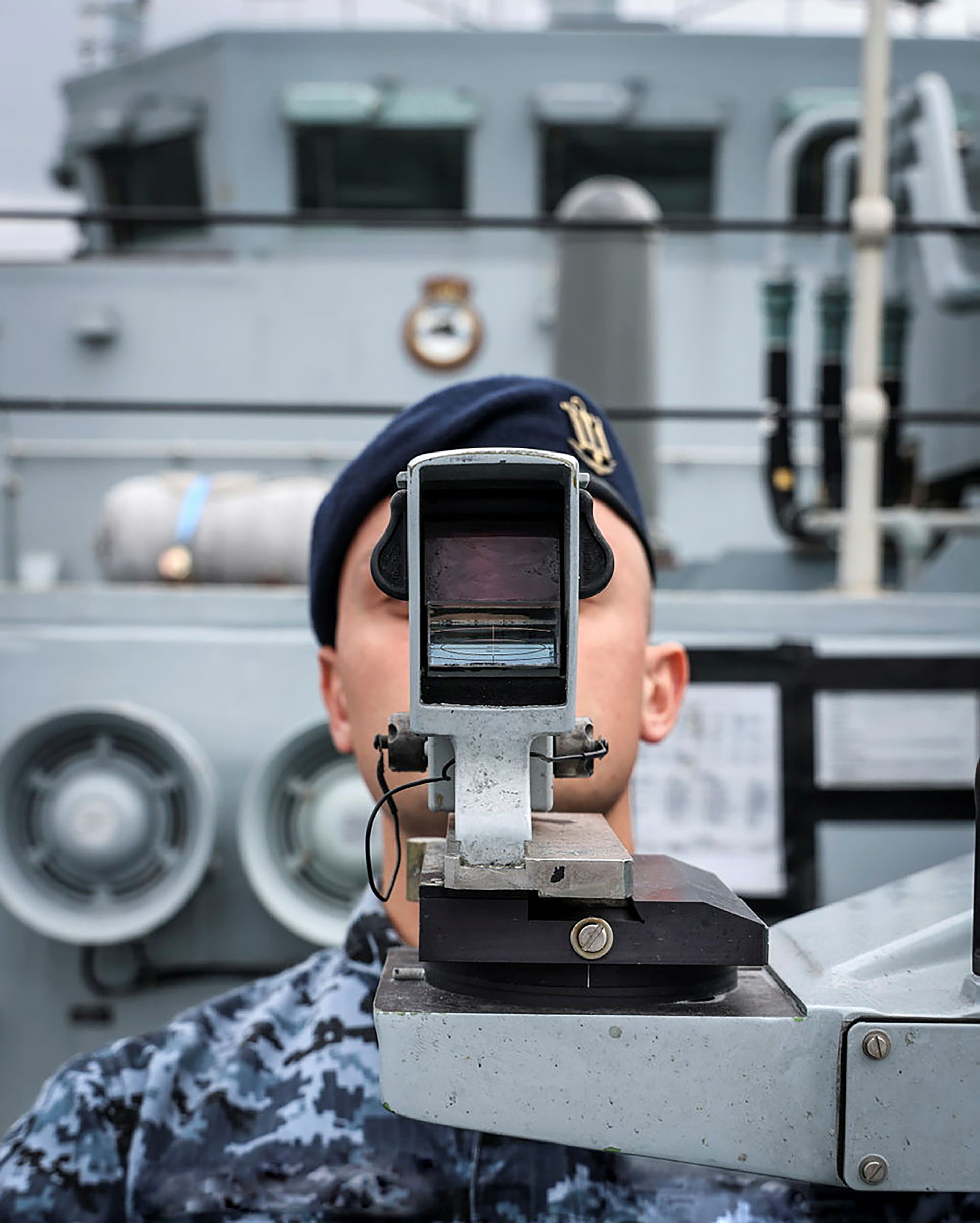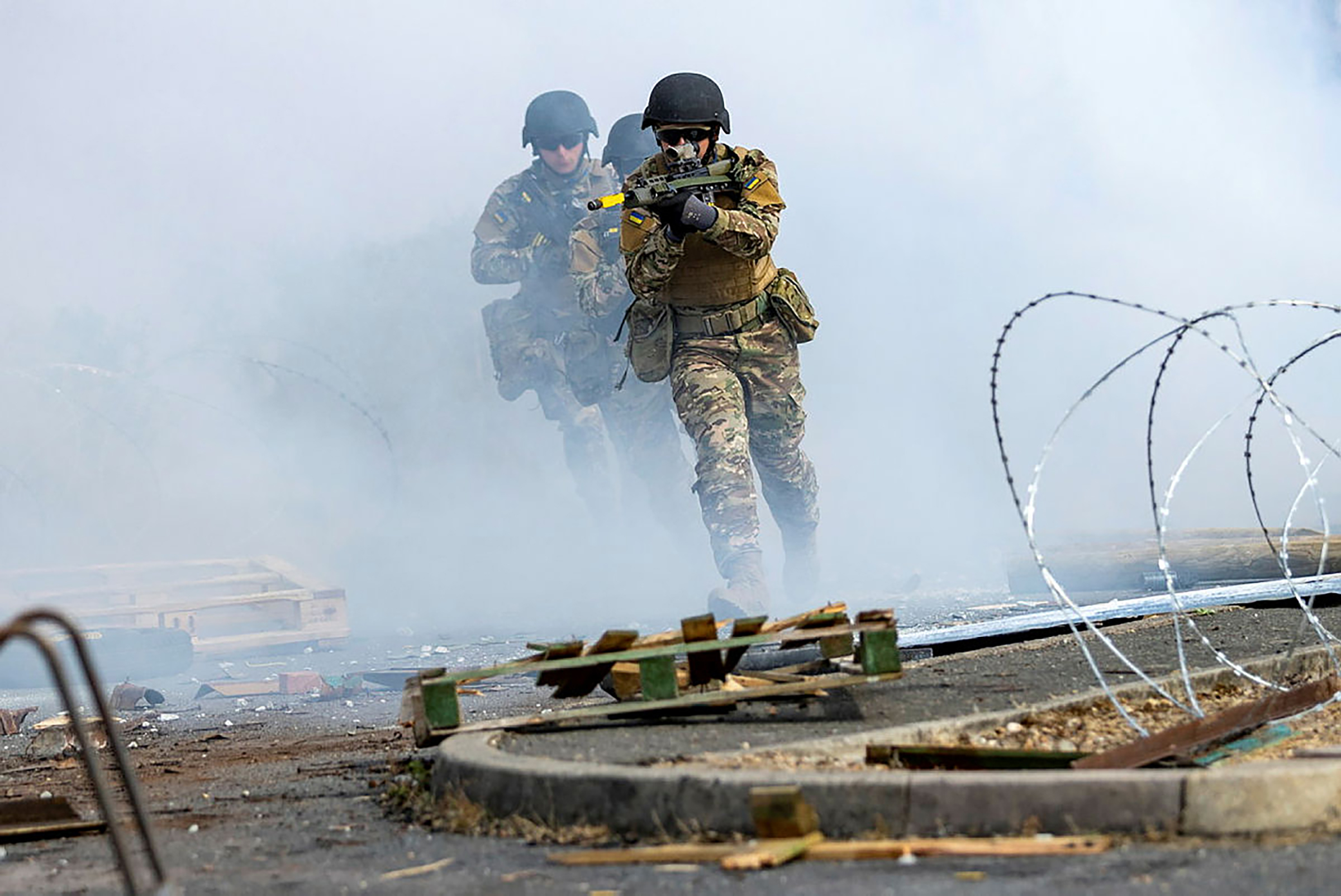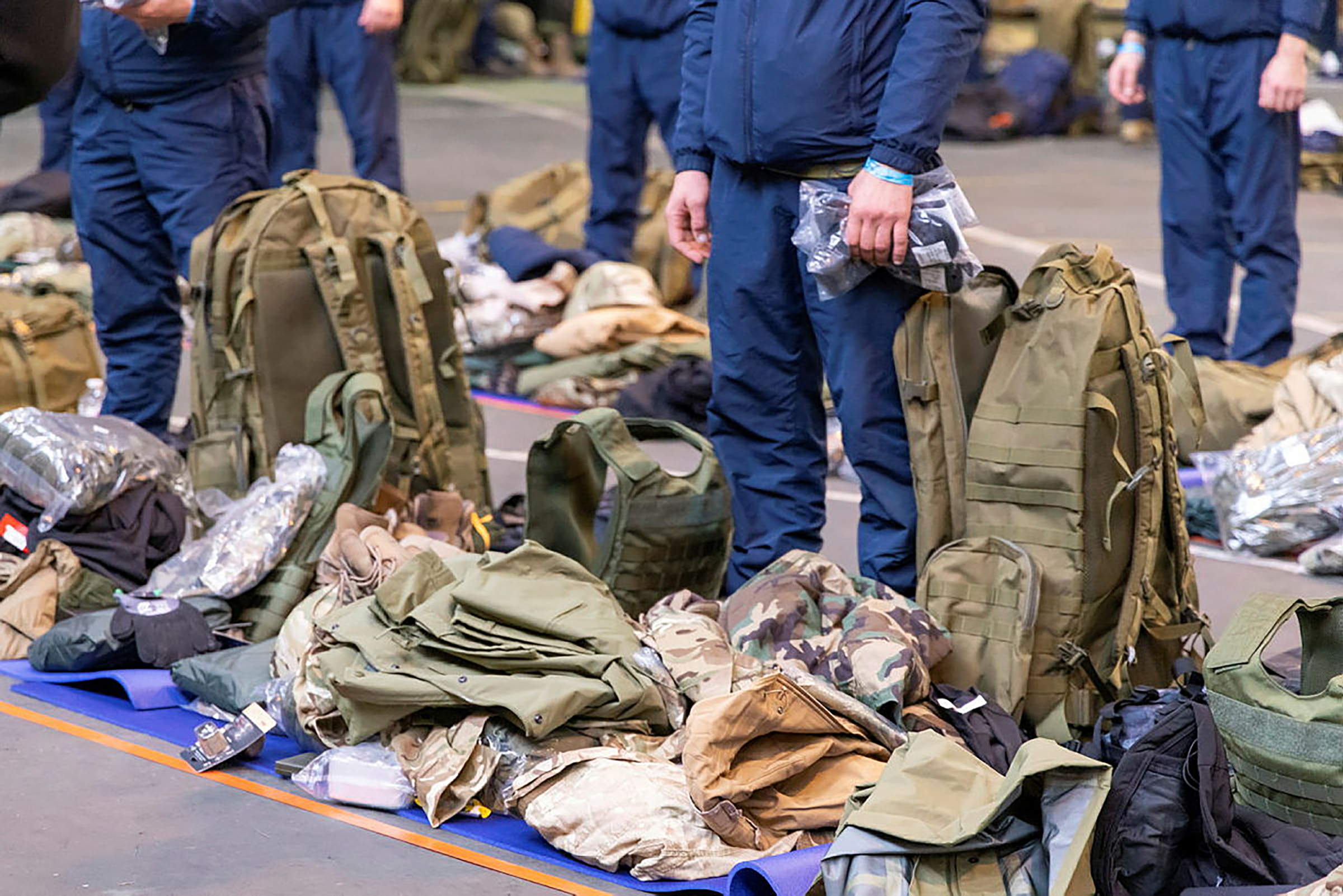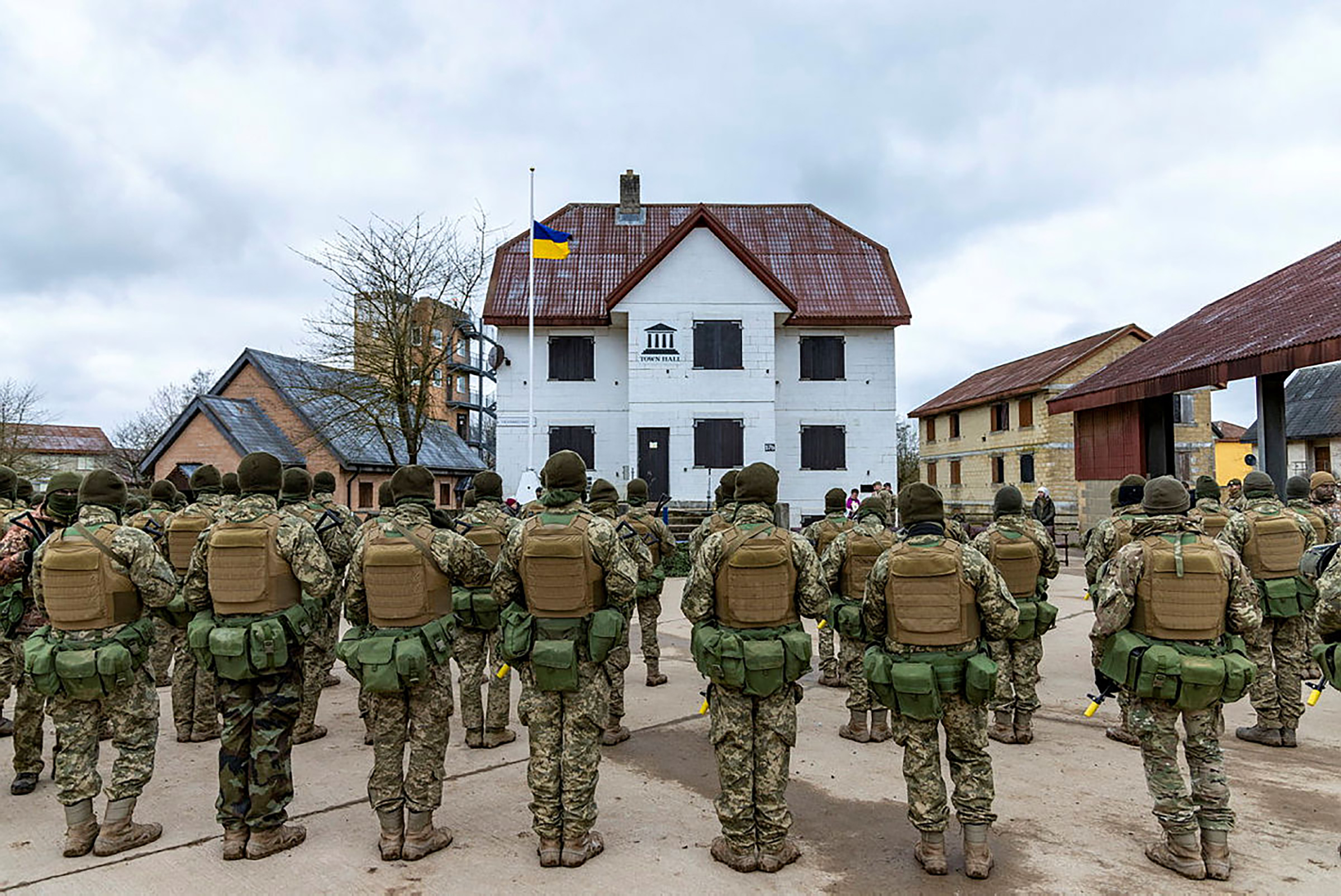
Tall and lanky, Sasha towers over the uniformed recruits who march past us as we stand on the edge of a large wheat field where battle formation training is about to begin. Although the 31-year-old is dressed in Ukraine’s standard issue combat uniform and has a rifle slung across his chest, he doesn’t come across as a stereotypical infantryman. He is soft spoken, with long, strawberry blonde hair wrapped up in a man bun and kind blue-green eyes. Perhaps that’s because he isn’t a hardened soldier—at least, not yet.
Sasha is one of more than 23,000 Ukrainian civilians who have undergone basic infantry training as part of Operation Interflex, the first and most ambitious training program of Ukrainian recruits outside of Ukraine. The U.K.-led multinational program—with trainers from nine countries as far afield as Canada, Finland, and Australia—provides Ukrainians with little to no military experience with the skills and equipment they need to defend their homeland against Russia’s ongoing invasion in just five weeks. Here at a secret location in the rural east of England, where the largest of the Operation Interflex program is being run, recruits are taught everything from weapons handling to battlefield first aid to trench warfare. Of all the West’s contributions to the Ukrainian war effort thus far, this is perhaps the most hands-on.
Before arriving in the U.K. in mid-August, Sasha was a filmmaker and wood carver. (For security reasons, Sasha and other recruits TIME spoke to asked to be identified by first name only.) His peers were programmers, nurses, physical therapists, and carpenters. Most of them contributed to the war effort before they donned their combat uniforms. In Sasha’s case, he worked with his mother, a real estate agent, to help house those who had been internally displaced by the war. When he came across military recruitment officers one day on the streets of his native Kamianets-Podilskyi in western Ukraine, he volunteered. “I saw them and I understood that all this time, I wasn’t being as useful as I would have liked to be,” he tells TIME via a translator. “When in the end I was given my recruitment papers, this was weird but I became happier, you could say. Everything happened as it was supposed to happen.”

By the time you read this, Sasha and his fellow recruits will have completed their combat training. While some will have been selected to undergo further training, perhaps as part of a leadership or specialist course, most will have already returned home, where they will soon be bound for the frontline. What awaits them is a grinding war of attrition as Ukraine continues its counteroffensive efforts to break through Russian defenses and wrest back its territory.
More From TIME
“The Ukrainians intend to degrade Russian defenses to such an extent that they can exploit it and then try to conduct a penetration, a breach, and a breakthrough,” Riley Bailey, a Russia analyst at the Washington, D.C.-based Institute for the Study of War, says of the Ukrainian offensive. He notes that Ukraine’s operations are currently focusing around Bakhmut and Donetsk Oblast in eastern Ukraine, as well as in its south-eastern Zaporizhzhia Oblast.
Read More: Inside the Race to Arm Ukraine Before Its Counteroffensive
Prior to Russia’s full-scale invasion, Ukraine’s army totaled around 300,000 people. Today, that figure has swelled closer to 1 million, including reserves and conscripts. Operation Interflex’s contribution to the Ukrainian war effort has been vital, particularly as Kyiv tries to ramp up its recruitment efforts as it faces an enemy with a considerable manpower advantage. A press officer with the Ukrainian armed forces tells TIME that whereas training centers in Ukraine have been exposed to heavy Russian shelling, in Britain recruits “can train without any fear.”
The expansive farm fields of the British military estate—not dissimilar to the open and flat landscapes that Ukrainian soldiers might expect to encounter on the frontline—makes for an ideal training ground. In one such field, a group of recruits are trained to operate a Next Generation Light Anti-Tank Weapon, or NLAW—large green tubes, thousands of which have been gifted to Kyiv by the British government, that have proven instrumental in the Ukrainian army’s ability to destroy Russian tanks from short range. In another, more wooded area, Swedish trainers bark orders as they demonstrate how to move through dense forests. Nearby, in a purpose-built town modeled after a European village, recruits are trained in urban combat exercises.

But it’s not just the terrain of war that Operation Interflex intends to replicate; it’s the sounds, the smells, and the feel of war, too. For that, the program incorporates audio effects (including explosions, shooting, and screaming) and brings in make-up artists who adorn actors with fake wounds. They’ve even procured meat from the local slaughterhouse in order to simulate the smell of rotting flesh. “It needs to be realistic,” a British army officer involved in Operation Interflex training tells TIME. “It needs to hit home.”
Yulia, a 34-year-old recruit from the central Ukrainian city of Poltava, isn’t put off by such training. If anything, she says it gives her greater assurance that she’ll be prepared for what awaits her back home. “Everything is maximally close to the conditions that are waiting for us on the front,” she says as we walk down a gravel road typically reserved for armored vehicles and the occasional neighborhood sheep. Though smaller than many of her fellow recruits, with neatly braided brown hair, Yulia beams with confidence. She is still high off the adrenaline of having completed her latest training exercise, which involved traversing lakes and rivers with injured soldiers in tow. A single mother, Yulia’s life before the Russian invasion was spent raising her two children, aged 13 and three, who are back in Ukraine with her parents. Now, she says she is fighting for their future.
“My daughter is three years old and when she hears air raid sirens, she shouts, ‘Mummy, there’s an air raid, let’s go to shelter!’” Yulia says. “Children aren’t supposed to know this.”
Yulia is one of the relatively few women in Operation Interflex—women make up just 1.6% of the overall recruits participating in the program, according to the U.K.’s Ministry of Defence; roughly 60,000 women currently serve in the Ukrainian army, according to Ukrainian officials—but she says she isn’t treated differently to the men. And though she has only been here a few weeks, she is confident that she will be ready to fight when the time comes. “These last three weeks, I’ve learned more than in the last 10 years of my civilian life,” she says. “I have realized that I can do a lot more than I thought initially.”

“A woman can do anything,” she adds, grinning. “Ukrainian women are strong.”
Five weeks is a relatively short period to undergo basic infantry training. Ed Arnold, a research fellow for European security at the London-based Royal United Services Institute and a former British army officer, tells TIME that he had over three years of training before he ever stepped foot onto a warzone. But Ukraine doesn’t have the luxury of time nor an unlimited roster of soldiers at its disposal. Though Kyiv does not disclose its death toll, which it considers a state secret, U.S. officials estimate that as many as 70,000 Ukrainians have been killed, according to the New York Times—a staggering figure for an army of Ukraine’s size. “What’s been happening up until this point is they’re pretty much absorbed straight into combat units and pushed to the front to deal with casualties,” Arnold says of new recruits. “I’d rather have five weeks than not have the five weeks, but it’s really quite basic.”
None of the recruits who spoke with TIME expressed any disquiet about what awaits them, perhaps because the reality of war has been a feature in their lives for so long. “I wanted to be useful,” says Ivan, a 36-year-old from Vinnytsia Oblast in central Ukraine. When the full-scale invasion began, he was among the many volunteers who were ultimately turned away from the recruitment centers and told to wait for when they were needed. “I did what was expected of me, but I was also very scared,” he admits. Ivan is among the older recruits of his section, which is betrayed by the flecks of gray in his dark brown hair. When I ask if he is still scared, he says no. “If not me, then who?” he asks. He has a wife and a teenage daughter back home, as well as two dogs, two cats, and a pet chinchilla. He wants to protect them. “I won’t feel well if I just spend my time in the rear.”
Read More: How Russia Is Recruiting Cubans to Fight in Ukraine
Alexie, a 35-year-old warehouse manager from the Russian-occupied city of Melitopol, shares that feeling. As he fiddles with his rifle, he recalls how on the day the full-scale invasion began, he and his wife and daughter woke up to the sounds of explosions. Though he had no military experience, watching his friends go off to defend their country made him feel restless. “It got to the point where it was hard to fall asleep at night,” he says. “Here I feel more free. ... It was that bit that was missing.”
Operation Interflex, which in June marked its first anniversary, is on track to have trained 30,000 people by the end of this year. And as the war rages on, the program isn’t planning on wrapping up its work anytime soon. If anything, it’s expanding in order to meet Ukraine’s needs. In addition to the basic infantry course, Interflex has recently expanded to offer training for Ukrainian marines and combat medics. The program is also expected to begin offering flight training for Ukrainian pilots, though the U.K. government has yet to confirm when that will officially commence.

It’s difficult to measure the success of a program like Operation Interflex. Its stated goal is to increase both the lethality and survivability of the recruits who come through the program, as well as respond to the needs of the Ukrainian army on the ground. But Interflex’s organizers have no way of knowing how many of their recruits survive the frontline or what impact, if any, they have on battlefield progression.
But as far as their Ukrainian counterparts are concerned, this program is a win-win for both Ukraine and its international partners. “Ukrainians are the only soldiers in the world today who have experience of a full-fledged, large-scale war with an enemy of superior strength,” says Yehor Cherniev, a Ukrainian lawmaker and the deputy chairman of the Ukrainian Parliamentary Committee on National Security, Defense, and Intelligence. “British friends share their knowledge with our soldiers, our soldiers share their practical experience, and this makes both sides stronger.”
While the war has no clear end in sight, that hasn’t stopped these Ukrainian recruits from dreaming about their lives after it does. Some have made plans to go into business together after the war. “We’ve already chosen the technical directors, the instructors, the business directors—we’ve thought of everything!” says Ivan, who with his fellow recruits plans to start a training camp for teenage Ukrainians. Others are planning to see more of the world. Most, especially the parents, are just motivated by the promise of living in a country where no child knows what an air raid alarm sounds like.
“We want to learn as fast as we can, to understand, to remember everything, because this is our future,” says Ivan, a 35-year-old former professional soccer player from Bilozerka, in southern Ukraine. “If we train badly, everyone knows what the final could look like—and we don’t want to be in second place. Only victory.”
More Must-Reads From TIME
- The 100 Most Influential People of 2024
- How Far Trump Would Go
- Scenes From Pro-Palestinian Encampments Across U.S. Universities
- Saving Seconds Is Better Than Hours
- Why Your Breakfast Should Start with a Vegetable
- 6 Compliments That Land Every Time
- Welcome to the Golden Age of Ryan Gosling
- Want Weekly Recs on What to Watch, Read, and More? Sign Up for Worth Your Time
Write to Yasmeen Serhan at yasmeen.serhan@time.com